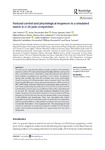Mostrar o rexistro simple do ítem
Postural control and physiological responses to a simulated match in U-20 judo competitors
| dc.contributor.author | Carballeira, Eduardo | |
| dc.contributor.author | Santos, Luis | |
| dc.contributor.author | Fernández-Río, Javier | |
| dc.contributor.author | Iglesias-Soler, Eliseo | |
| dc.contributor.author | Blanco-Traba, Miguel | |
| dc.contributor.author | Dopico-Calvo, Xurxo | |
| dc.contributor.author | Jakobsen, Markus Due | |
| dc.contributor.author | González Díez, Vicente | |
| dc.contributor.author | Franchini, Emerson | |
| dc.contributor.author | Gutiérrez-García, Carlos | |
| dc.contributor.author | Amonette, William | |
| dc.contributor.author | Suman, Oscar | |
| dc.date.accessioned | 2024-04-22T17:01:42Z | |
| dc.date.issued | 2020 | |
| dc.identifier.citation | Santos, L., Fernández-Río, J., Iglesias-Soler, E., Blanco-Traba, M., Jakobsen, M. D., González-Díez, V., … Suman, O. (2020). Postural control and physiological responses to a simulated match in U-20 judo competitors. Sports Biomechanics, 19(3), 281–294. https://doi.org/10.1080/14763141.2018.1461237 | es_ES |
| dc.identifier.issn | 1476-3141 | |
| dc.identifier.uri | http://hdl.handle.net/2183/36295 | |
| dc.description.abstract | [Abstract] : The aim was to evaluate the e"ects of judo combat on the athletes’ postural control (PC) and physiological loading before, during and after a simulated match. Seventeen under-20 regional and national level athletes completed one modi#ed 7-min match. At baseline, during the combat (3rd and 7th minutes) and 2-min post-match centre of pressure (CoP) parameters were assessed. Heart rate (HR), blood lactate (BLa) and rating of perceived exertion (RPE) and local RPE (LRPE) were collected. Signi#cant increments were observed in CoP mean positioning and velocity at 3rd and 7th minutes, but the CoP deviation in both axes was una"ected. HR and BLa were elevated at 3rd and 7th minutes, and they remained elevated 2-min postmatch. However, CoP returned to baseline 2-min post-match. RPE was elevated at 3rd and 7th minutes and the greatest e"ort was displayed in the Deltoid and Quadriceps. Thus, one simulated judo match stimulates a signi#cant metabolic response and balance is degraded, with the greatest e"ects on the anterior–posterior axis and it recovers to baseline level after 2 min of passive rest. The physiological load cannot be regarded as a potential predictor variable of CoP. Overall, a judo match predominantly a"ects the upper body than the other body parts. | es_ES |
| dc.language.iso | eng | es_ES |
| dc.publisher | Routledge | es_ES |
| dc.relation.uri | https://doi.org/10.1080/14763141.2018.1461237 | es_ES |
| dc.subject | Judoists | es_ES |
| dc.subject | Stability | es_ES |
| dc.subject | Combat | es_ES |
| dc.title | Postural control and physiological responses to a simulated match in U-20 judo competitors | es_ES |
| dc.type | info:eu-repo/semantics/article | es_ES |
| dc.rights.access | info:eu-repo/semantics/embargoedAccess | es_ES |
| dc.date.embargoEndDate | 9999/99/99 | es_ES |
| dc.date.embargoLift | 9999 | |
| UDC.journalTitle | Sports Biomechanics | es_ES |
| UDC.volume | 19 | es_ES |
| UDC.issue | 3 | es_ES |
| UDC.startPage | 281 | es_ES |
| UDC.endPage | 294 | es_ES |
| dc.identifier.doi | https://doi.org/10.1080/14763141.2018.1461237 |
Ficheiros no ítem
Este ítem aparece na(s) seguinte(s) colección(s)
-
GI-PHG - Artigos [112]






